Are you hoping to reduce the amount of heat radiating through your patio roof this summer? Insulating your metal patio roof is a great way to dramatically improve its thermal efficiency. In this blog post, we’ll explore which insulating materials are best for protecting yourself from the elements and how to insulate a metal patio roof.
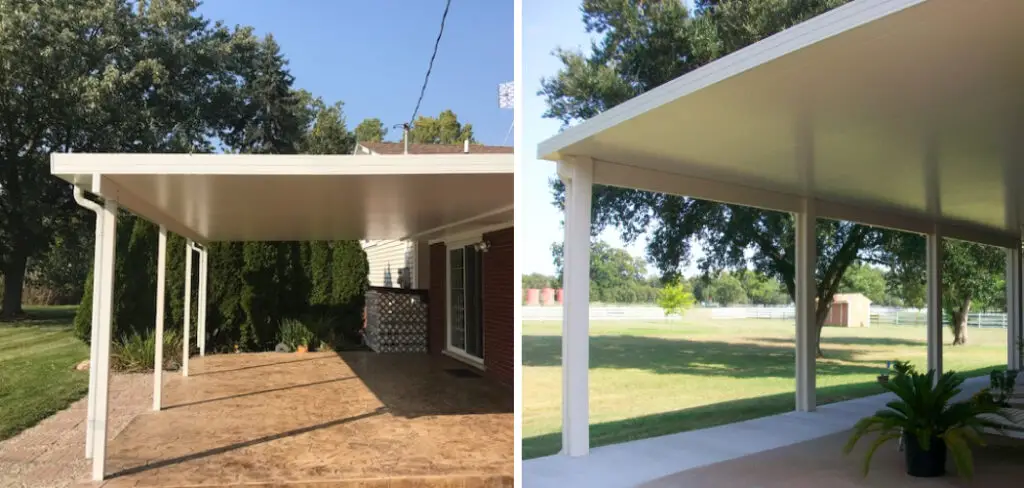
We’ll also discuss other creative solutions that can help keep things comfortable while lowering utility costs too! If you’re ready to take on the challenge of improving your outdoor living space, let’s get started with everything you need to know about insulating a metal patio roof!
Do You Need Foam Strips on a Metal Roof?
Foam strips are an optional way to insulate a metal patio roof. They come in many different sizes and can be installed between the ribs of the roof, providing additional insulation that helps keep heat out during summers and cold air out during winters.
However, this type of installation is labor-intensive, difficult to install correctly, and may not be necessary for every location or climate. If you choose to install foam strips, the best practice is to use a closed-cell type with an R-value of at least 4 per inch. This can help reduce energy costs while making the patio more comfortable and enjoyable year-round.
Be sure to measure the size of your metal roof carefully before purchasing foam strips, as they come in various widths and lengths. Make sure to measure both the horizontal ribs and the vertical ribs of your metal roof, as well as its total area.
When installing foam strips on a metal patio roof, make sure to start at one end of the roof and work your way down. Leave enough space between each strip so that they don’t touch each other when compressed by weight from above. When you have finished laying out the foam strips, seal them with duct tape if necessary for extra security.
Finally, use high-quality silicone caulk around all edges of the strips before sealing them with aluminum foil or another waterproof material.
Be sure to measure your patio roof carefully before purchasing foam strips, and follow the instructions above when installing them. Doing so can ensure that your metal patio roof is properly insulated and performing at its best.
10 Methods How to Insulate a Metal Patio Roof
1. Polycarbonate Panels
Polycarbonate panels are a great way to insulate a metal patio roof. The panels are made of a clear, rigid plastic that is very effective at reflecting sunlight and keeping heat out. Additionally, polycarbonate panels are very lightweight and easy to install.
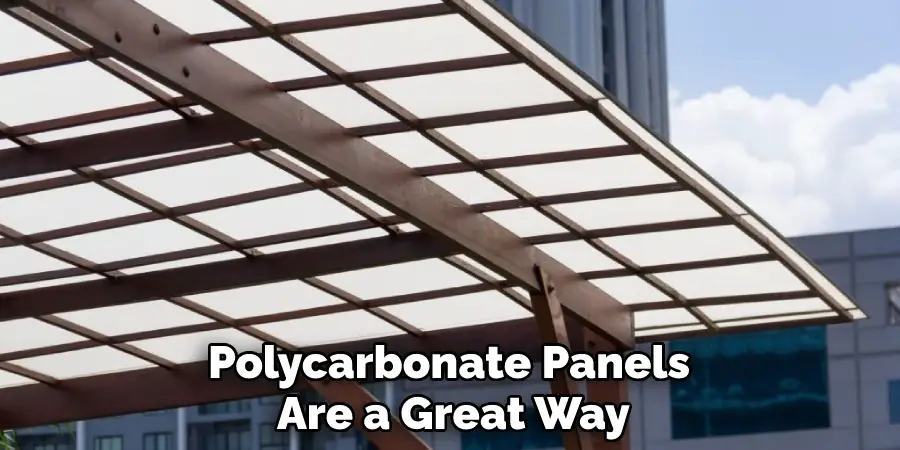
If you choose to use polycarbonate panels, it is important to make sure they are securely attached to the roof frame and double-check that all seams and joints are sealed properly. This will help ensure that the panels are not damaged in windy conditions and keep your patio roof insulated all year round.
2. Spray Foam Insulation
Spray foam insulation is another great option for insulating a metal patio roof. The foam is applied directly to the roof and expands to fill any gaps or cracks. Spray foam insulation is very effective at preventing heat transfer and can also help to reduce noise levels. It is also very easy to install and can be done in a few hours.
The only downside of spray foam insulation is that it can be expensive, so it may not be the best option for those on a budget. However, if you are looking for an effective way to insulate your metal patio roof, spray foam insulation is definitely worth considering.
3. Rigid Foam Insulation
Rigid foam insulation is another option that can be used to insulate a metal patio roof. The foam comes in sheets that are cut to fit the specific dimensions of the roof. Rigid foam insulation is very effective at preventing heat transfer and can also help to reduce noise levels.
It is important to ensure that the insulation is securely attached to the roof in order to prevent it from slipping or shifting. Once properly secured, the rigid foam insulation can provide reliable protection from the elements. Additionally, using rigid foam insulation is one of the most cost-effective ways to insulate a metal patio roof.
4. Fiberglass Insulation
Fiberglass insulation is another material that can be used to insulate a metal patio roof. The insulation comes in rolls that are placed between the rafters of the roof. Fiberglass insulation is effective at preventing heat transfer and can also help to reduce noise levels.
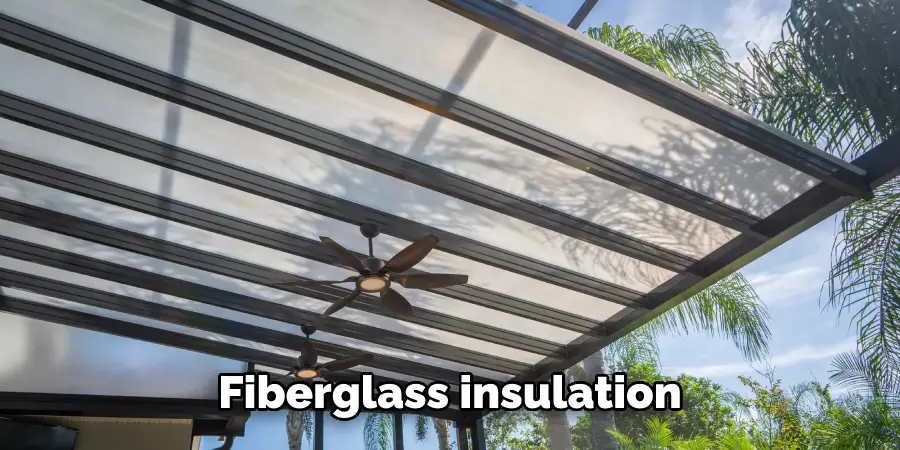
It is important to make sure that the insulation is placed correctly and securely so that it does not become loose or allow air to escape.
Additionally, it is important to wear protective gear when working with fiberglass insulation, as it is made of very small fibers that can irritate the skin and lungs if breathed in. Once the fiberglass insulation is installed, it should be covered with a vapor barrier to prevent moisture from entering and damaging the insulation.
5. Reflective Insulation
Reflective insulation is another material that can be used to insulate a metal patio roof. The insulation comes in sheets that are placed on top of the metal roofing panels. Reflective insulation reflects sunlight and helps to keep the area beneath the roof cooler.
This type of insulation is also easy to install and can be purchased in various sizes to fit the area you are insulating. It is important to lay the insulation in the correct way so it can properly reflect sunlight. The reflective insulation should be placed on top of the metal paneling and should be secured with metal fasteners.
6. Radiant Barrier
A radiant barrier is another material that can be used to insulate a metal patio roof. The barrier consists of a reflective material that is placed on top of the metal roofing panels.
Radiant barriers reflect heat away from the area beneath the roof, keeping it cooler in the summer months. This is especially useful in climates with hot summers. Installing a radiant barrier can help reduce cooling costs associated with the patio roof.
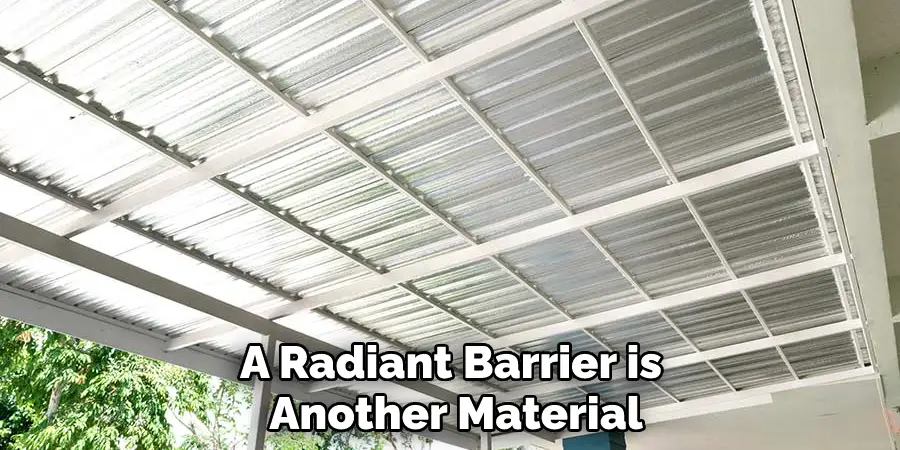
The barrier should be installed by a professional and should be checked periodically to ensure it is still performing correctly.
7. Shade Cloth
Shade cloth can be used to provide additional protection from the sun for a metal patio roof. The cloth is placed over the top of the roof and blocks out some of the sunlight, helping to keep the area beneath the shade cloth cooler.
Shade cloth can be purchased in a variety of colors, sizes, and materials. Choose one that is specifically designed for outdoor use and also provides adequate UV protection. This additional insulation can help keep a metal patio roof cooler in the summer and warmer in the winter.
8. Trees and Shrubs
Planting trees and shrubs around a metal patio roof can provide additional protection from the sun’s rays. The trees and shrubs will provide shade for the area beneath the metal roof, helping to keep it cooler in the summer months. Additionally, plants can help to improve air quality and provide other environmental benefits.
Be sure to consider the mature size of trees and shrubs before planting them near the metal roof, as their roots may damage the structure if they get too large.
9 . Awnings
Installing an awning over a metal patio roof can provide additional protection from the sun’s rays. Awnings are available in a variety of materials, including fabric, aluminum, and canvas. When selecting an awning, be sure to choose one that is durable and will withstand wind and weather conditions.
10. Foam Strips
Adding foam strips to a metal patio roof can be a great way to increase its insulation and make it more energy-efficient. However, this is an optional step that may not be necessary for all locations or climates. Be sure to measure your patio roof carefully before purchasing foam strips, and follow the instructions provided by the manufacturer for proper installation.
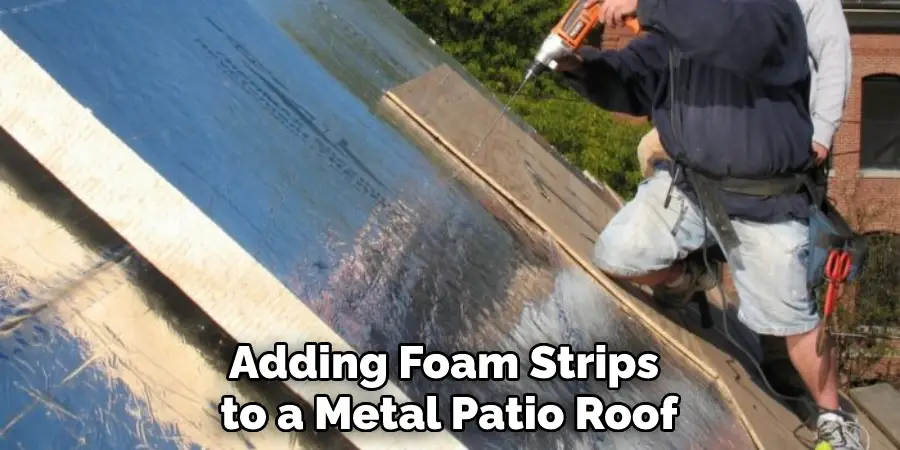
Adding insulation to a metal patio roof is a great way to help keep it cooler in the summer months and more energy-efficient all year round.
There are several methods that can be used to insulate a metal patio roof, including polycarbonate panels, spray foam insulation, rigid foam insulation, fiberglass insulation, reflective insulation, radiant barriers, shade cloths, trees and shrubs, awnings, and foam strips.
Conclusion
Applying insulation to your metal patio roof is a great way to reduce heat transfer and keep your outdoor space comfortable all year round. Insulating your patio roof will also help to reduce noise levels coming from outside. There are a variety of insulating materials available on the market, so be sure to do some research before making a purchase.
Once you have the right supplies, follow the instructions carefully to ensure that your insulation is installed properly. Thanks for reading our blog post on how to insulate a metal patio roof! We hope you found it helpful and informative.
About
Outdoor Fixes is a distinguished figure in the world of Diy design, with a decade of expertise creating innovative and sustainable Diy solutions.
His professional focus lies in merging traditional craftsmanship with modern manufacturing techniques,
fostering designs that are both practical and environmentally conscious. As the author of diy,
outdoorfixes delves into the art and science of outdoorfixes-making, inspiring artisans and industry professionals alike.
Education RMIT University
(Melbourne, Australia) Associate Degree in Design (Outdoor Fixes) Focus on sustainable design, industry-driven projects,
and practical craftsmanship. Gained hands-on experience with traditional and digital manufacturing tools, such as CAD and CNC software.
Nottingham Trent University
(United Kingdom) Bachelor’s in outdoorfixes.com and Product Design (Honors) Specialized in product design with a focus on blending creativity with production
techniques. Participated in industry projects, working with companies like John Lewis and Vitsoe to gain real-world insights.
Publications and Impact
In diy, Outdoor Fixes his insights on indoor design processes, materials, and strategies for efficient production.
His writing bridges the gap between artisan knowledge and modern industry needs, making it a must-read for both budding designers and seasoned professionals.

